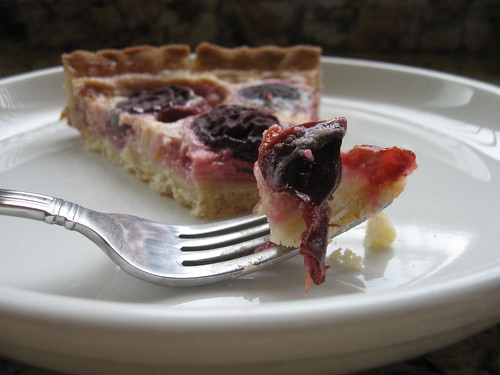Living in a metropolitan sprawl like L.A., though, leads to some pretty skewed views of "local". The surrounding area is filled with farms - but when I visit my local farmers' market, more than half of the farmstands are from the Central Valley - the long, fertile strip of land that runs for 500 miles through the middle of California. I understand the reason - according to my good friend Wikipedia, the Central Valley contains 1% of the country's farmland and produces 8% of its crops - but how, I ask you, is a farm 200 miles away providing "local" food?
With this in mind, I focus all the more on seasonality - my plums may not be truly local, but they're nothing like the Chilean plums I see in stores in December. I've had many people, my husband included, question the concept of seasonal eating. Do I really want to go six months without a tomato? Ten without a cherry? Well, no, of course not - the short season of cherries is one of the great cruelties of life.

I pretty sure that the traditional method to deal with wanting all foods year round would be to suck it up - I think Laura Ingalls had more to worry about in November than a sad lack of fresh peaches - but my method is a little different. Basically, I gorge myself on my favorite foods until I don't want to touch them for six months. After that point, it's a short wait until they're in season again.
In this spirit, I offer you another plum recipe. I've been eating plums since they showed up in June, but I find the late-season prune plums the best for cooking. In this tart, plums are simply halved and baked with the simplest custard, resulting in a sweet-tart pastry that is ideal for breakfast, dessert, or an afternoon snack. The custard is lightly pink-stained around the plums, and the prune plums collapse, wrinkling their dusty, purple-black skin - finally they match their names.

Prune Plum Tart
Inspired by Molly's recipe at Orangette and Dorie Greenspan's "Crunchy and Custardy Peach Tart"
For the crust:
1 ½ cups unbleached flour
½ cups confectioners' sugar
¼ teaspoon salt
9 tablespoons unsalted butter, well chilled and in several pieces
1 large egg yolk
For the filling:
12 small to medium prune plums
¼ cup heavy cream
¼ cup whole milk
¼ cup granulated sugar
1 large egg
⅛ teaspoon vanilla extract
Preheat the oven to 400ºF.
In a food processor, whiz the flour, sugar, and salt together. Add the butter and pulse until it is a oatmeal/pea consistency (this won't take long - just a few seconds). Add the yolk in a few drizzles, pulsing briefly each time, then pulse in 10-second increments until the dough just comes together - the processor will make a slightly unnerving rattling sound right before this happens.
Press the dough quickly into a 9 or 10 inch tart pan with a removable bottom, then transfer to the freezer until you are ready to assemble the tart.
Halve and pit the plums, then set aside. In a small bowl, whisk together the cream, milk, sugar, egg, and extract until well combined.
Place the tart crust on a baking sheet. Arrange the plums, cut side down, in the tart crust. Gently pour the custard over the plums. Place the baking sheet in the oven and bake, 45 minutes to an hour, until the custard has just set and the crust is nicely browned. Cool on rack.
Serves 8

I have also had my husband question my intentions with eating locally and seasonally but he has come around. I just try to do my best, and hope that my best is good enough to make a difference.
ReplyDeleteYou bring up some interesting points, a nice tart, and I like your gorging method ; )
ReplyDeletePersonally, I eat items such as tomatoes when they are in season simply because they taste so much better than tomatoes I find at other times of the year. If I could find a tomato in November and it was somehow luscious, yet not in season or local, I'm not sure I'd hold back.
We usually cave a few times with tomatoes - they're passable for a lot of the winter here in L.A., but they dont' usually have much flavor.
ReplyDeleteIf there were a magical land where all other food changed with the seasons but tomatoes were juicy, flavorful, and delicious year-round, I would be there!
I'm with you Margie and Denise. I don't really want to eat the winter strawberries that we get at our farmers markets in LA. They are no treat.
ReplyDeleteOn the other hand, I can recommend the tomatoes that come from the North Shore of the Salton Sea - they actually have flavor and make excellent sauce and juice. They are not the same as summer slicing tomatoes, but they fill the void.